
This is the image Tone sent me when we came up with the idea of crossing a Fender Jaguar with a Gibson reverse Firebird back in 2005/6 when I was still making guitars fairly regularly. I usually say to Tone "what would it look like if you crossed a .......... with a ............ " and he sends back a picture like this. Sometimes they work, like this, sometimes they don't.
I'm a big fan of making guitars that are hybrids of other models. Taking the "best" parts of certain guitars and mixing them with the best parts of others. As a guitar maker I never really understood when someone asked me to make a "Tele" ? You can buy "Teles" from $200 to $20 000. If I'm making something completely from scratch, what would be the point ?
The reverse Firebird is such a great shape and lends itself to the Fender offset so well. The Firebird in general was a little too close for Fenders liking back in the day.
I started with working out what would be best for the body timber. I had some old (about 80 year old) pieces of Honduran mahogany that I'd bought from an old wood turner/DIY furniture guy which were big enough to laminate into guitar bodies but was very valuable as pieces of timber. I decided not to use it for the whole body but to laminate pieces of Bunya pine (my favorite solidbody guitar body timber) to each side of the mahogany for weight and looks.


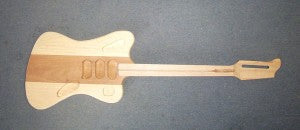

Being Maton fans we decided to use the classic Maton half classical headstock to add a little more originality to the mix. While it's a strange looking headstock, it actually works really well and is very comfortable to tune as the top row are adjusted from the back, like the banjo tuners on the original Gibson Firebirds. Maton used this headstock on the Wedgetail, which is a rare 60's model.
With the body shaped and routed it was time for a little paint. While I personally don't think nitro "sounds" any "better/different" on a solidbody electric than acrylic, I do like the way it finishes and ages, so I decided to use a nitro clear coat for sealing/filling and top coats. The pine is tight grained and doesn't need filling but the mahogany needs a bit so I needed to apply and sand more to the centre block.
I wanted this to have a real vintage look and the centre stripe was so dark with the clear on that I decided to go for a tabacco burst around the edges while keeping as much of the original timber colour as possible.
Once the tabacco burst went on I really started to love the look of this shape with this timber combination.
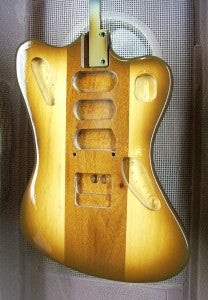
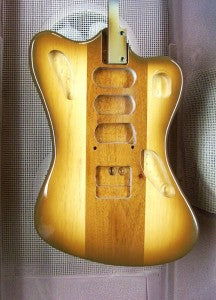
The neck is Queensland Maple, which I use on most of my guitar necks. I've made over 100 guitars from scratch, although not many for the last five or six years due to time, and also made custom necks for people and most have been Queensland maple. It's a GREAT neck building timber. It is very close to the weight and strength of nice mahogany and is easy to shape and work with.
My fretboards are primarily jarrah which I started calling "West Australian rosewood" to convince guitarists to let me use it. It's a native hardwood that can be SO hard it's crazy. I do thickness them down and leave them to air dry for very long periods as it can be unstable once cut if not dried properly. Once it's dry and flat, you could play it for 40 years and not make a mark in it.





The hardware is all Fender Jaguar with three Jag pick ups all wired up to the offset wiring loom. The three slider switches on the bottom plate turn each pick up on or off but everything else is the same with the exception of the rhythm switch engages the bridge and neck pick up together.
The neck is pencil thin and shaped off one of my '65 Mosrite Ventures with medium Fender size frets. The other thing you may notice is no inlays in the fretbaord. No dots of blocks. I like the "clean" look of this and I never really use the front markers anyway when playing. There are side dot markers in very small dots like a Mosrite. In keeping with the more Fender side things there's no neck binding either.
It's a Gibson (24.5") scale length so that sits halfway between the Jaguar and Jazzmaster and is one of my favorite scales for "soft timber" solidbodies. If I want a real "trebbly bite" I'd tend to use a hard maple (or ash) neck with a longer 25.5" scale. In my opinion the body timber has less influence on frequencies than is currently accepted.


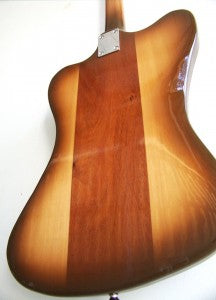
The vibrato is Fender offset but moved closer to the bridge like I did on all my builds that used this system. It's a great vibrato but needs that tension on the bridge to work well with the bridge. You do loose some harmonics from moving the tailpiece closer like this but I wasn't trying to make it sound like an offset anyway, so it didn't matter.
The other advantage of this for me is that I tend to strum close to the neck and the arm now reaches further towards the neck. Not that I use the vibrato a lot but this suits my style better.
The chrome plates are all straight off a Jaguar and fit the body shape without any modifying although the top plate is a "little" off :)
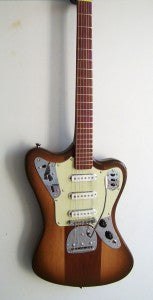



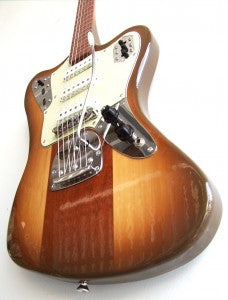
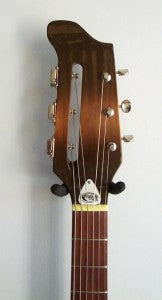
I went for a bolt on neck, again to keep in the Fender style and I personally think the disadvantages of a set neck outweigh the advantages. Also, when I make guitars for customers who I can't sit down and talk with it's always hard to get the neck shape, size, radius etc right and I'm always happy to make a neck for one of my guitars if it's not EXACTLY right for who I made it for. Bolt on necks make this process MUCH easier. Necks I make for myself are always VERY thin and small with very low frets as that's how I like them.
I don't have pics of most of my guitars but I have found some on old CD's saved from old hard drives so I'll attempt to find time to do some more of these blogs if people want them and find them interesting.
